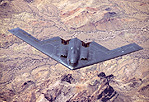Northrop Grumman Begins Installing First EHF Satcom Hardware on B-2
 EDWARDS AIR FORCE BASE, Calif., March 17, 2010 (GLOBE NEWSWIRE) -- Northrop Grumman Corporation (NYSE: NOC) technicians here have begun installing the first set of hardware for a B-2 stealth bomber upgrade that will eventually allow the jet to send and receive battlefield information up to 100 times faster than its current satellite communications system. The work is being done as part of Increment 1 of the U.S. Air Force's B-2 extremely high frequency (EHF) satellite communications program.
EDWARDS AIR FORCE BASE, Calif., March 17, 2010 (GLOBE NEWSWIRE) -- Northrop Grumman Corporation (NYSE: NOC) technicians here have begun installing the first set of hardware for a B-2 stealth bomber upgrade that will eventually allow the jet to send and receive battlefield information up to 100 times faster than its current satellite communications system. The work is being done as part of Increment 1 of the U.S. Air Force's B-2 extremely high frequency (EHF) satellite communications program.
Northrop Grumman is the Air Force's prime contractor for the B-2 Spirit, the flagship of the nation's long range strike arsenal, and one of the world's most survivable aircraft systems. The B-2 is the only combat-proven stealth platform in the current U.S. inventory.
"EHF Increment 1 puts in place the high speed data handling infrastructure that the B-2 will need to perform its most advanced communications and weapons delivery missions in the future," said Col. Kevin Harms, USAF, Commander, 702nd Aeronautical Systems Group. "The beginning of hardware installation means that we are making solid progress getting this new capability out of the lab and into the hands of the warfighter."
"The installation of EHF Increment 1 hardware also means that we're nearly done with a significant task of software development, integration and testing for the program," added Dave Mazur, Northrop Grumman's vice president of long range strike and B-2 program manager.
According to Mazur, the new software was developed, integrated and tested by Northrop Grumman employees working at the Air Force's Weapon Systems Support Center, Tinker AFB, Okla. Ground testing of the EHF Increment 1 hardware is planned early in 2010.
The first "kit" of EHF Increment 1 hardware includes:
•A new integrated processing unit (IPU) developed by Lockheed Martin Systems Integration, Owego, NY., that will replace up to a dozen current stand-alone avionics computers on the B-2;
•A new disk drive unit developed by Honeywell Defense and Space Electronic Systems, Plymouth, Minn., that will enable transfer of EHF data onto and off of the B-2; and
•A network of fiber optic cable that will support the high speed data transfers within the aircraft.
The three-increment EHF Satcom program is part of an on-going effort by the Air Force and Northrop Grumman to modernize the B-2 to keep it fully mission capable against evolving enemy threats.
Increment 2 involves installation of a new communications terminal and new antennas that will allow the B-2 to transmit and receive information securely via satellite. Increment 3 will integrate the B-2 into the U.S. Department of Defense's Global Information Grid, a worldwide network of information systems, processes and personnel involved in collecting, storing, managing and disseminating information on demand to warfighters, policy makers and military support personnel.
The B-2 is the only U.S. aircraft that combines stealth, long range, large payload and precision weapons in a single platform. In concert with the Air Force's air superiority fleet, which provides airspace control, and the Air Force's tanker fleet, which enables global mobility, the B-2 helps ensure an effective U.S. response to threats anywhere in the world. It can fly more than 6,000 nautical miles unrefueled and more than 10,000 nautical miles with just one aerial refueling, giving it the ability to reach any point on the globe within hours.
The 20-aircraft fleet of B-2s is operated by the 509th Bomb Wing from its headquarters at Whiteman AFB, Mo.